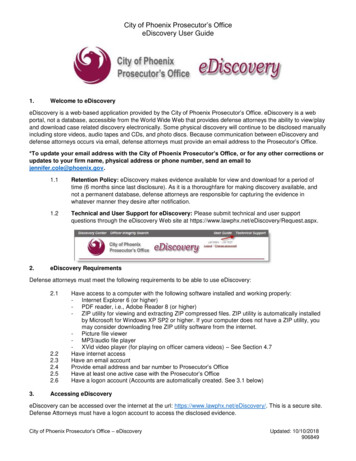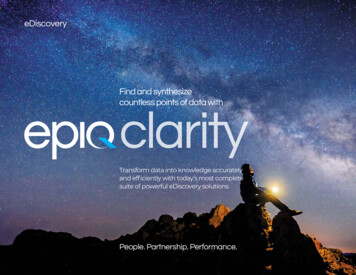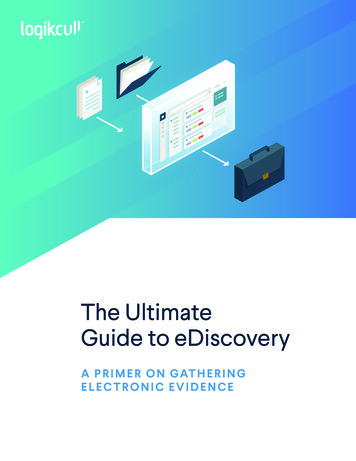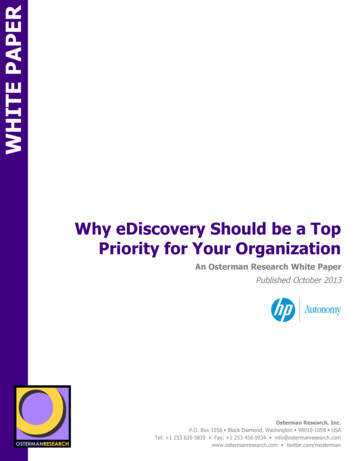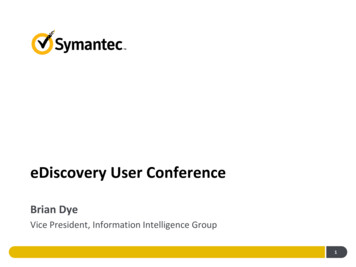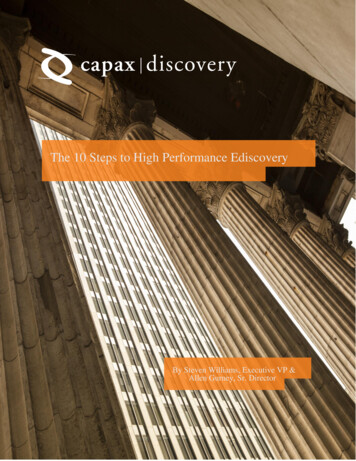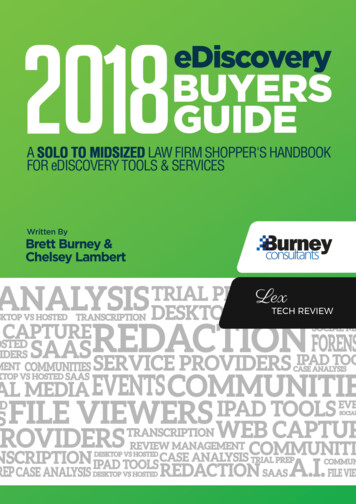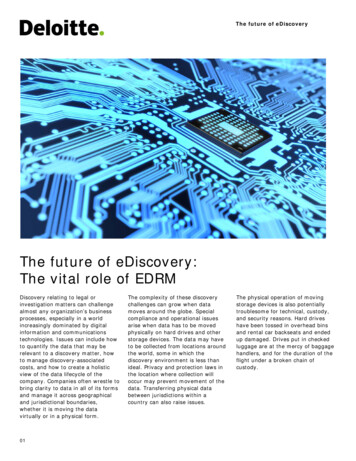
Transcription
The future of eDiscoveryThe future of eDiscovery:The vital role of EDRMDiscovery relating to legal orinvestigation matters can challengealmost any organization’s businessprocesses, especially in a worldincreasingly dominated by digitalinformation and communicationstechnologies. Issues can include howto quantify the data that may berelevant to a discovery matter, howto manage discovery-associatedcosts, and how to create a holisticview of the data lifecycle of thecompany. Companies often wrestle tobring clarity to data in all of its formsand manage it across geographicaland jurisdictional boundaries,whether it is moving the datavirtually or in a physical form.01The complexity of these discoverychallenges can grow when datamoves around the globe. Specialcompliance and operational issuesarise when data has to be movedphysically on hard drives and otherstorage devices. The data may haveto be collected from locations aroundthe world, some in which thediscovery environment is less thanideal. Privacy and protection laws inthe location where collection willoccur may prevent movement of thedata. Transferring physical databetween jurisdictions within acountry can also raise issues.The physical operation of movingstorage devices is also potentiallytroublesome for technical, custody,and security reasons. Hard driveshave been tossed in overhead binsand rental car backseats and endedup damaged. Drives put in checkedluggage are at the mercy of baggagehandlers, and for the duration of theflight under a broken chain ofcustody.
The future of eDiscoveryEmerging technologies expandthe challengesNew technologies further increase thecomplexity of quantifying andcollecting data for discovery.eDiscovery, which started withunstructured data in emails, nowencompasses diverse devices, datasources, and technologies. Potentiallydisruptive future change agents ineDiscovery include:Artificial intelligence (AI). AIdriven technology-assisted review isalready helping identify relevanteDiscovery information. Could AI endup writing the emails rather thanpeople?Blockchain. Applying this distributeddatabase technology to eDiscoverycould be extremely complex. At thesame time, blockchain’s inherentcharacteristics could make it a keytechnology that enhances thediscovery process.Cloud services. Exactly wheregeographically is cloud data stored? Alack of proper controls and custody ofeDiscovery data in the cloud couldprove detrimental during a discoveryprocess.The Internet of Things. Biowearsuch as smart watches and thegrowing array of smart appliances allcollect data. How long until thesedevices are routinely swept intoeDiscovery collection activities?Creating what privacyconsiderations?02Crowdsourcing. What are the legalimplications for the company, andthe crowd, in a discovery order? Howcould discoverable crowd membersbe tracked down efficiently?All of these technologies aretransforming the world’s social fabric.How will they impact discovery, andhow can companies prepare now fora future that potentially changes soquickly?The vital role of EDRMOrganizations typically work withtheir external counsel and serviceproviders to address the complex,time-consuming, and costlyeDiscovery process. Even large-scaleprojects are often self-containedefforts, with organizational resources,counsel, and service providerscoalescing around a specific matter.Since 2005, the Electronic DiscoveryReference Model (EDRM) has helpedguide organizations through thediscovery process for electronicallystored documentation that may berequired in an investigation orlitigation (Figure 1). Created andmaintained by a community ofeDiscovery and legal professionals,the EDRM helps organizations selecteDiscovery software tools, determinethe skillsets needed to operate thosetools, and design documentation thatmaps the process from end-to-endfor legal purposes.
The future of eDiscoveryFigure 1. Electronic Discovery Reference ModelWhile the EDRM continues to providea valuable framework for eDiscoveryactivities occurring outside anorganization’s enterprisearchitecture, the growing demands,and stakes, of discovery arecompelling many companies to takemore control internally, as well.Expanding data volumes, file types,and storage options are increasingthe challenge of identifying,preserving, and collecting data fromthe breadth of sources that mightreasonably be deemed under acompany’s control. Also to beconsidered are regulators’ andjudges’ expectations for the qualityand type of data presented inresponse to inquiries and in civillitigation. This is one reasoncompanies are seeing the need totransform eDiscovery from an islandof activity into an integrated, end-to-03end business process (see GlobaleDiscovery: An integrated, end-toend approach).Integrating the EDRM internallyCan the EDRM be seamlesslyintegrated into a company’s businessarchitecture, rather than remain astandalone tool? Figure 2 envisionsan evolved eDiscovery model inwhich data collection and processingare brought forward in the EDRMlifecycle to coexist with informationmanagement. Collection andprocessing are defined processestoday. However, in the future,advanced analytics and othertechnologies could enable eDiscoveryto reach into an organization like aliving organism and undertakecollection and processinginstantaneously with transparency.
The future of eDiscoveryFigure 2. EDRM evolutionThe evolved EDRM model frontloadsdecision-making into the informationmanagement process, taking stock ofdata at its time of creation,cataloging it, and associating it withits metadata. The information is athand and can be tapped effectivelyfor collection and processing into thediscovery business-as-usual model.Retention of records that are notrelevant and should have beendestroyed has caused increases incost and risk profile for manyorganizations facing a discoveryaction. The analysis phase of theevolved model addresses the keyissue of defensible deletion, ordefensible disposition, of data. Whiledefensible deletion was notconsidered as part of the originalEDRM model, it is now at theforefront of information managementand a significant factor in thediscovery lifecycle.04Knowing what can and cannot bedeleted across a global company thathas litigation hold orders fromnumerous regulatory or litigationmatters creates a maze of complexitywith overlapping data sources andtimelines. Adding to the complexity,legacy platforms and past employeesare among the challenging issuesthat make the task of mapping anddefining litigation holds even moreonerous. Before any information canbe defensibly deleted or disposed,the data universe relating to thelitigation hold needs to be clear andconcise.The process to reach this statefollows along the lines of normaldiscovery in that the process must bedefensible. Including defensibledeletion in the evolved EDRM makessense as it is then part of the normaldata lifecycle of a company. In sucha scenario, data could be trackedthrough its lifecycle using advancedanalytic tools that focus on not onlythe content of the data, but the
The future of eDiscoverycontext of the information and themetadata therein. And at the data’send of life, it is deleted with arigorous, defensible audit trail. Nolonger is the company overwhelmedwith the complexity of litigation holdorders or understanding what, where,how, and when data can be disposed.eDiscovery adapts to thedigital eraThe digital era is unfolding, and it islikely to offer many more excitingand beneficial advances in virtuallyall areas of life. Yet as existing digitaltechnologies mature and emergingtechnologies go mainstream, theyalso present challenges – forexample, making the job ofeDiscovery increasingly complex anddemanding. Certainly, technology willplay a role in taming the discoverylandscape, but technology alone isn’tthe solution. An integrated, end-toend discovery operating model isanother key element. So is anevolved EDRM that incorporates datacollection and processing into anorganization’s broader datamanagement processes. Such anapproach frontloads those activitiesso data is categorized, stored, andeventually disposed of in astructured, legally defensible way.This approach provides a solidframework for managing anorganization’s eDiscovery processeseven as the world around thatorganization rapidly changes.Contact us:Andy RuckmanPrincipalDeloitte DiscoveryDeloitte Transactions and BusinessAnalytics LLPTel: 1 202 370 2270Email: aruckman@deloitte.comAbout DeloitteAs used in this document, “Deloitte” and “Deloitte Risk and Financial Advisory” meansDeloitte & Touche LLP, which provides audit and enterprise risk services; Deloitte FinancialAdvisory Services LLP, which provides forensic, dispute, and other consulting services; and itsaffiliate, Deloitte Transactions and Business Analytics LLP, which provides a wide range ofadvisory and analytics services. Deloitte Transactions and Business Analytics LLP is not acertified public accounting firm. These entities are separate subsidiaries of Deloitte LLP. Pleasesee www.deloitte.com/us/about for a detailed description of our legal structure. Certainservices may not be available to attest clients under the rules and regulations of publicaccounting.This document contains general information only and Deloitte Risk and Financial Advisory isnot, by means of this document, rendering accounting, business, financial, investment, legal,tax, or other professional advice or services. This document is not a substitute for suchprofessional advice or services, nor should it be used as a basis for any decision or action thatmay affect your business. Before making any decision or taking any action that may affect yourbusiness, you should consult a qualified professional advisor. Deloitte Risk and FinancialAdvisory shall not be responsible for any loss sustained by any person who relies on thisdocument.Copyright 2017 Deloitte Development LLC. All rights reserved.05
The future of eDiscovery 02 Emerging technologies expand the challenges New technologies further increase the complexity of quantifying and collecting data for discovery. eDiscovery, which started with unstructured data in emails, now encompasses diverse devices, data sources, and technologies. Potentially disruptive future change agents in


